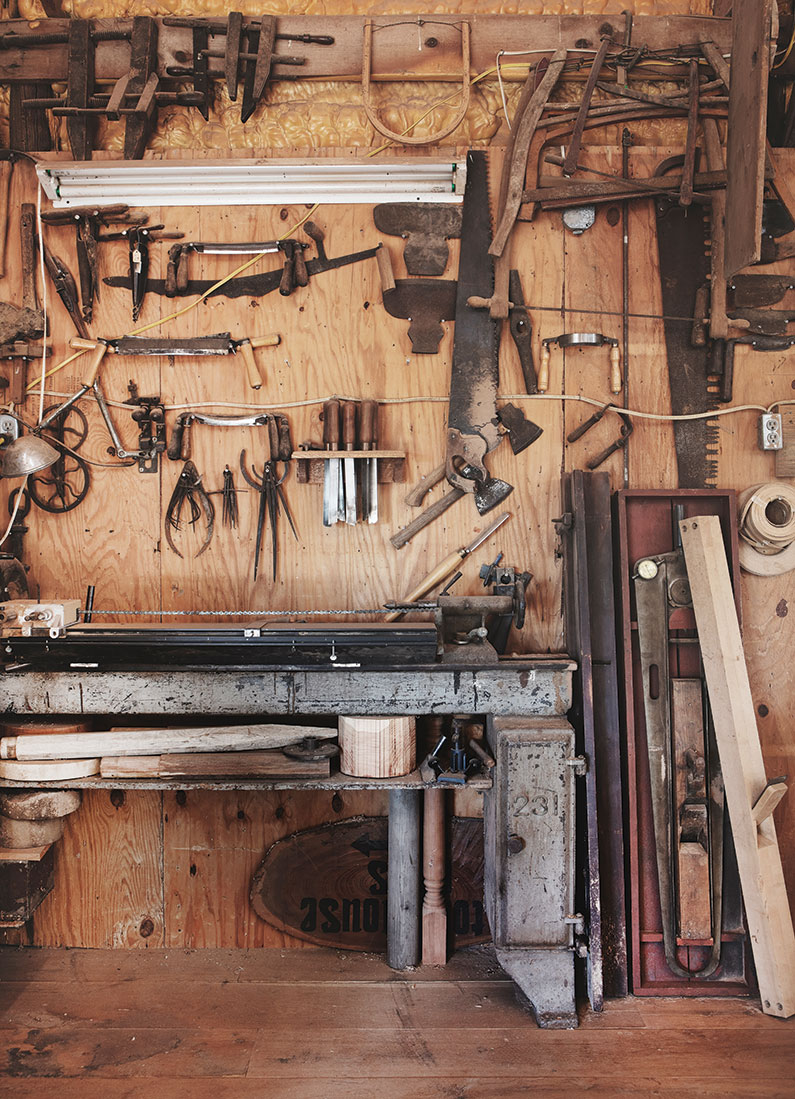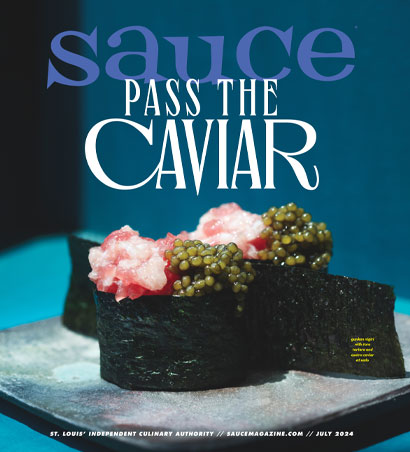How David Stine Furniture has helped build the St. Louis restaurant scene
David Stine is measuring enormous, rough slabs of wood and taking photos of them for his archives. Someday these will be smooth, live edge tables where people will eat or work, but for now, they just rest on the ground of his new 12,000-square-foot workshop in Dow, Illinois, keeping form as a massive cross-sectioned tree. Stine pulls a flat piece of metal out of the middle of one of the slabs.
“Here’s a bullet,” he says. “Probably 50 or 60 years old.” He finds a lot of old bullets in these trees. He’s also found nails, horseshoes and a full ax head. The trees grow around them over time, like a river flowing around rocks.
The wood comes from Stine’s 1,000-acre family farm, half of which holds timber: red and white oak, walnut, maple, sycamore, cherry and ash. As the link between the nature his trees come from and the homes and businesses where they end up, Stine harbors an incredible knowledge of the intertwining histories of wood and style.
Get him going and he’ll talk with ease – while operating a forklift – about the tables of George Nakashima and Brian Boggs, about how blight destroyed most of the existing population of American chestnut in the 1920s and about why blue-stain, beetle-kill pine has become so popular over the past few years.
Stine’s bread and butter appears to be restaurant work – he’s provided tables for Louie, Balkan Treat Box, Elmwood, Gioia’s Deli, The Midwestern, even Shake Shack – but about half his commissions are residential, where he does everything from dining room and coffee tables to beds. Watching him work on a humid September morning, I ask what his favorite project has been, bringing up a headboard/nightstand combo I recently saw on Instagram.
“Probably that one,” he responds, laughing. “My favorite thing is usually whatever I’m working on at the time.”
“I think my favorite restaurant, in the way it looks as a whole, is probably Sardella,” he says. “It’s just really pretty and well put together. I did the bar and the tables in there – it’s legit old-school straight edge. I think my favorite live edge is the giant communal table in Balkan Treat Box. That’s actually the sister table to the Dia’s Room table in Cinder House. They’re from the same log.”
As he talks, I’m struck by how many pides and doners, how much foie gras and feijoada has been served on that single tree.

Tall, muscular and somewhat grizzled, Stine is the Midwestern version of a mountain man. Often clad in a dark purple David Stine Furniture shirt and jeans regardless of where he is, he dresses the part well. He’s disarmingly friendly. If you meet him in person, his large hand will swallow yours in a satisfying but aggressive handshake.
Stine grew up on a fourth-generation dairy farm in rural Illinois, learning about woodworking and carpentry from his grandfather. But he wanted to get out. “Milking cows fucking sucks,” he says. “It’s every day, twice a day, till you die. So going to school sounded like an awesome plan to me.”
Encouraged by his grandfather to go out into the world and learn how to keep the farm together, Stine left Illinois to attend undergrad at Penn State University. In 1993, he moved further east to enter law school at George Washington University in Washington, D.C.
He finished school, passed the bar and began practicing law, doing woodworking on the side to keep up his skills and stay connected to his roots. After a year as a lawyer, Stine found he didn’t enjoy working in an office. He decided to make the kind of major life shift most people only dream about.
But the decision wasn’t made alone. Around the same time, Stine’s roommate came home from Toledo Lounge, a bar in their D.C. neighborhood, with a surprising announcement.
“I just met your future wife,” she said, referring to one of the bar’s co-owners. The roommates immediately doubled back to the bar, and Stine met Stephanie Abbajay, who did, in fact, become his wife and business partner.

Abbajay grew up in Toledo, Ohio, where her father ran Country Palace – previously known as the Peppermint Club – a bar and country music establishment that saw performances from musicians like Jerry Lee Lewis, the Everly Brothers, Willie Nelson and Johnny Cash.
Like Stine, she wanted to forge her own path. She went to school at Kenyon College, then moved to D.C., where she contributed to numerous professional publications, ghostwrote books, developed programming for the United States Information Agency as an appointee of the George H.W. Bush administration and, eventually, opened Toledo Lounge in 1994.
She continued her freelance career until fairly recently, when David Stine Furniture began taking off. “The business has gotten so big that that’s what I do 100% of the time now,” she says. She seems happy with how things have turned out.
Stine and Abbajay moved to Illinois to continue David Stine Furniture in 2002. They bought the 40-acre farm in Dow, not too far from Stine’s family farm, and set up shop in a 3,000-square-foot barn right outside the main house, using the two buildings as their respective offices.

Their big break came with an order from James Beard Award-winner Gerard Craft; the chef and restaurateur needed tables for the second iteration of his lauded Niche in Clayton. Niche closed in 2016, but Stine’s work became a foundation of Craft’s restaurants going forward.
“I’m in the bag for Gerard,” Stine says, digressing to dote on his favorite menu items at Pastaria and Cinder House. “Whatever he does, I just love it.”
Today, Stine and Abbajay make a forceful duo. Abbajay describes their relationship as front of house and back of house. “I’m the business person; he’s the craftsperson. It seems to work pretty well that way,” she says. “I do all sales and marketing. I do all invoicing and receipts, accounts receivable. I do all the social media. I’m the first interaction with all the clients. When people send an inquiry for a piece of furniture, they meet with Dave personally.”
This is where the photos come in – Stine works closely with his clients to pick the right cuts of wood and to develop them to precisely fit the client’s tastes and environment. His immersion in the process is what sets him apart.

I talk to Stine and watch him work until noon, when he tells his employees to take an hour and ushers me to a Mercedes-Benz delivery van, where the conversation shifts toward the personal. As we head to lunch, he talks about going out in St. Louis the previous night with a client/friend. They wound up at Louie, drinking an undisclosed amount of tequila. Suffice it to say that within the restaurant industry, the lines between business and socializing can blur.
We drive the few miles through rural Illinois that separate the new workshop and showroom from their farm, where Abbajay is working in the office. When we arrive, it’s clear that she’s been doing more than work. A wonderful spread of homemade sauerkraut, pickled eggs, sweet pickles, sauerkraut pancakes, slow-cooked pork and tomatoes from Stine’s mother’s garden await.
Chatting for the next hour about restaurants, favorite dishes and events, it barely seems like a workday anymore. Their hospitality is astonishing – the more time I spend with Stine and Abbajay, the more I understand why they have been embraced by the St. Louis restaurant industry.
Our conversation continues as Stine opens some mail, skeptically reads over a bill and gets up from lunch to start doing the dishes. Eventually, though, he checks his watch and, surprised by how the time has passed, packs up to head back to the workshop. I stay at the house to chat with Abbajay, who is, unsurprisingly, incredibly well read. Our conversation ambles from Madame Bovary and Karl Ove Knausgaard’s My Struggle series back to the business.
Though they work out of the farm, their job often takes them right into the heart of St. Louis’ dining scene. “Our work isn’t mostly restaurants but, in St. Louis, much of it really revolves around the restaurant community,” Abbajay says. “So when we’re working, we’re at Elmwood, Louie, The Midwestern, Gioia’s, Strange Donuts. It’s really fun – it never feels like work. It’s pretty great to have a job where you can take clients to some of the best restaurants in the world.”

Abbajay is at the farm about three days a week, spending the rest of her time at their home in Clayton, where their daughter goes to school. They also have a son who lives in Chicago. Work and life can separate her and Stine, but they both feel it’s important to stay connected. “We try to see each other every day,” Abbajay says. “When our daughter graduates from high school, we’ll probably be out here full-time.”
Regardless, they’ll continue spending plenty of time in St. Louis. While discussing the pros and cons of working for yourself, she notes that it can be lonely. “I like to be in a social setting,” she says. “I like to be where other people are.”
Together, Stine and Abbajay have a bond that’s strong enough for all of these tons and acres of wood to rest on. It’s what makes David Stine Furniture possible, and it can be seen at nights out in the city, the parties they throw on the farm and in their working relationships with others.
Abbajay describes their typical date night as she finishes cleaning up from lunch. “We’ll get our daughter a sleepover, we’ll turn down invitations. Our schedule is so busy with clients, events, shows, travel, deliveries, that we have to schedule our alone time,” she explains. “Our date night is literally just us here at the farm with a giant steak, some great bottle of wine that Gerard [Craft] or somebody gave us. And we’ll work until 7, and then we’ll sous vide the steak, split the bottle of wine and watch Better Call Saul or Barry or something.” We should all be so lucky.
Adam Rothbarth is a staff writer at Sauce Magazine.
Tags : People
Most Recent
Drink this savory martini at The Lucky Accomplice in St. Louis
The Lucky Accomplice’s bar manager Corey Moszer is thinking outside the box …






